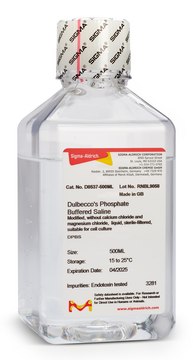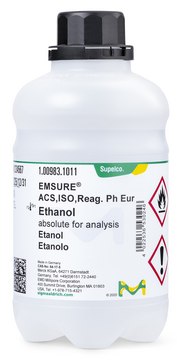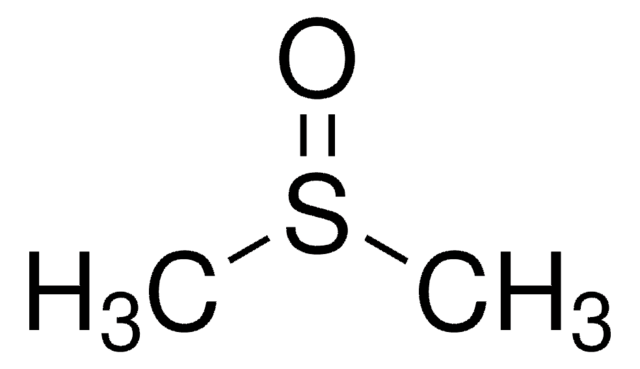100-1000
Ethanol (denatured)
≥85.0%, contains Molecular sieves
Synonym(s):
Ethanol denatured, Ethanol
Sign Into View Organizational & Contract Pricing
All Photos(1)
About This Item
Linear Formula:
C2H5OH
CAS Number:
Molecular Weight:
46.07
Beilstein:
1718733
MDL number:
UNSPSC Code:
15101802
PubChem Substance ID:
Assay:
≥85.0%
Recommended Products
Product Name
Alcohol dehydrated, ≥85.0%
Quality Level
Assay
≥85.0%
form
liquid
contains
Molecular sieves
availability
available only in Japan
SMILES string
CCO
InChI
1S/C2H6O/c1-2-3/h3H,2H2,1H3
InChI key
LFQSCWFLJHTTHZ-UHFFFAOYSA-N
Looking for similar products? Visit Product Comparison Guide
Application
for pathology
Legal Information
Distribution and use of the following types of ethyl alcohol in Switzerland require a license from the Swiss Federal Alcohol Administration.
Signal Word
Danger
Hazard Statements
Precautionary Statements
Hazard Classifications
Acute Tox. 4 Oral - Eye Irrit. 2 - STOT SE 1
Target Organs
Eyes,Central nervous system
Storage Class Code
3 - Flammable liquids
WGK
WGK 2
Flash Point(F)
Not applicable
Flash Point(C)
Not applicable
Personal Protective Equipment
dust mask type N95 (US), Eyeshields, Gloves
Regulatory Information
新产品
Choose from one of the most recent versions:
Already Own This Product?
Find documentation for the products that you have recently purchased in the Document Library.
Nicoletta Faraone et al.
Insects, 11(8) (2020-08-08)
Blacklegged ticks, Ixodes scapularis, represent a significant public health concern due to their vectoring of tick-borne disease. Despite their medical importance, there is still limited knowledge of the chemosensory system of this species, and thus a poor understanding of host-seeking
S Enocksson et al.
The Journal of clinical investigation, 95(5), 2239-2245 (1995-05-01)
Although it is well established in several mammalian species that beta 3-adrenoceptors play a major role in regulating lipolysis and thermogenesis in adipose tissue, the functional existence and role of this receptor subtype in man has been controversial. We investigated
Elhaseen E Elamin et al.
Nutrition reviews, 71(7), 483-499 (2013-07-03)
Ethanol is widely consumed and is associated with an increasing global health burden. Several reviews have addressed the effects of ethanol and its oxidative metabolite, acetaldehyde, on the gastrointestinal (GI) tract, focusing on carcinogenic effects or alcoholic liver disease. However
Thiago M Pais et al.
PLoS genetics, 9(6), e1003548-e1003548 (2013-06-12)
The yeast Saccharomyces cerevisiae is able to accumulate ≥17% ethanol (v/v) by fermentation in the absence of cell proliferation. The genetic basis of this unique capacity is unknown. Up to now, all research has focused on tolerance of yeast cell
Jeffrey M Skerker et al.
Molecular systems biology, 9, 674-674 (2013-06-19)
The efficient production of biofuels from cellulosic feedstocks will require the efficient fermentation of the sugars in hydrolyzed plant material. Unfortunately, plant hydrolysates also contain many compounds that inhibit microbial growth and fermentation. We used DNA-barcoded mutant libraries to identify
Our team of scientists has experience in all areas of research including Life Science, Material Science, Chemical Synthesis, Chromatography, Analytical and many others.
Contact Technical Service






